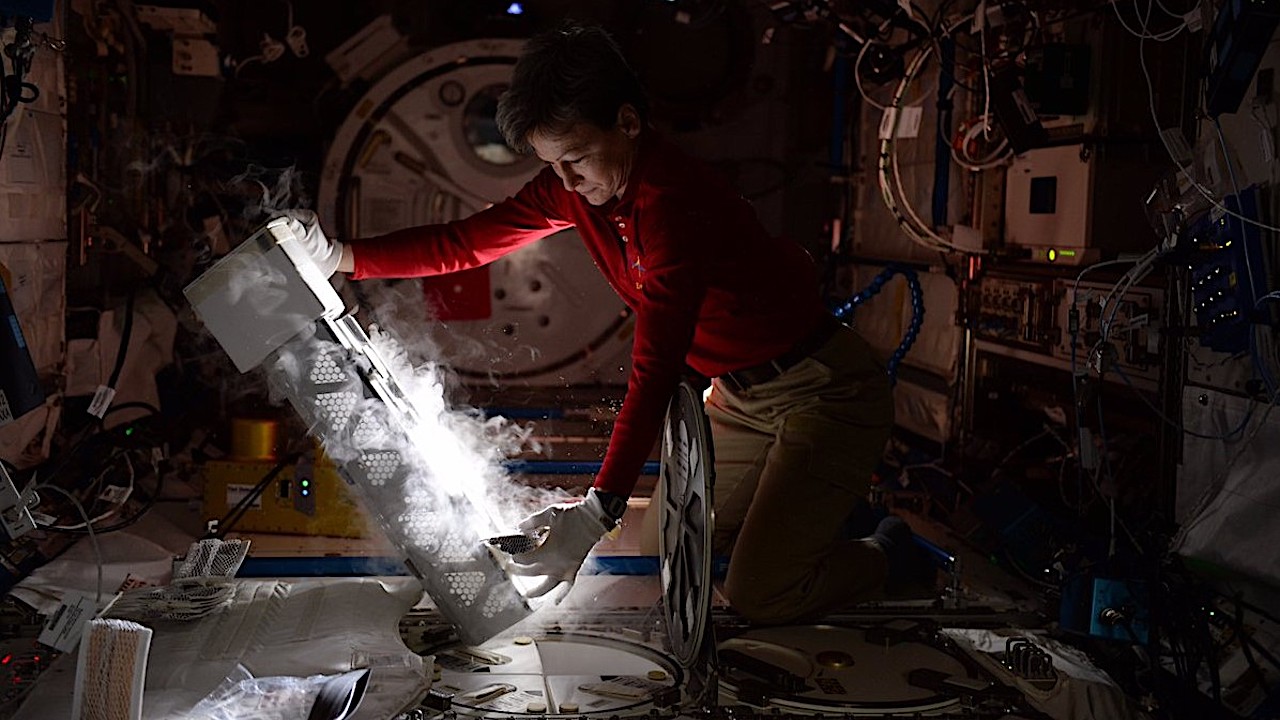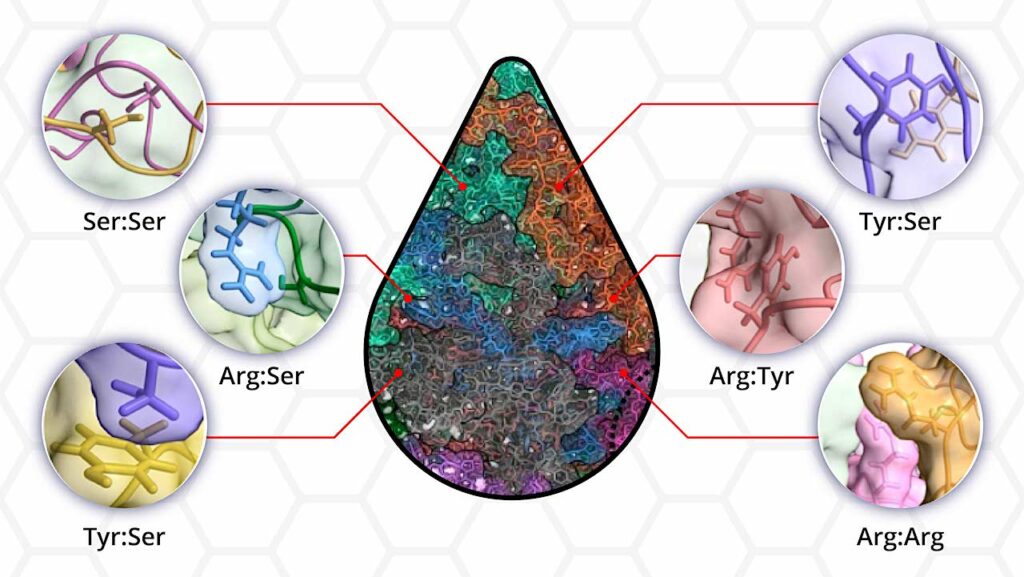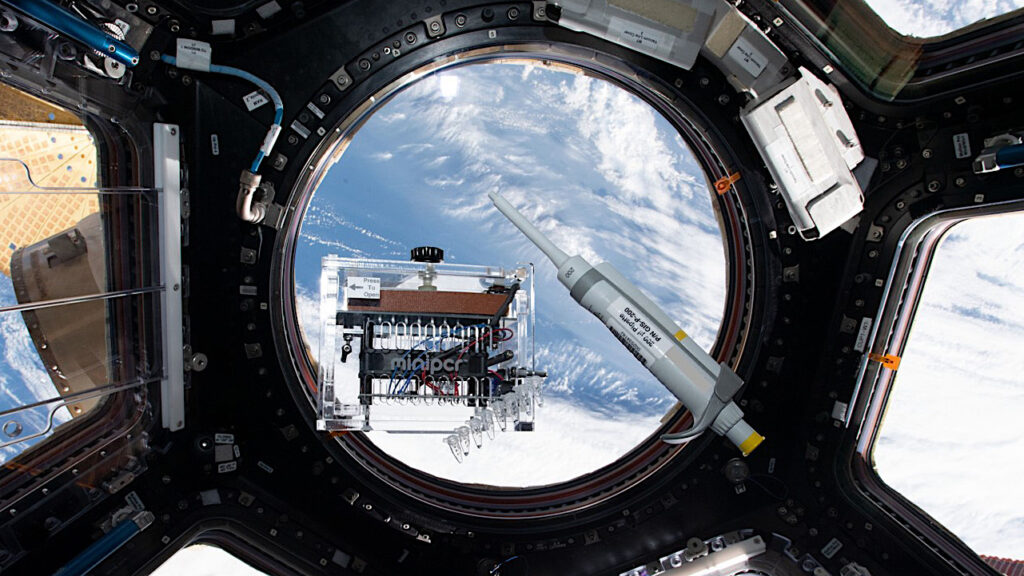NASA Spaceline Current Awareness List #1,100 17 May 2024 (Space Life Science Research Results)

Astronaut Peggy Whitson At Work on the ISS — NASA
The abstract in PubMed or at the publisher’s site is linked when available and will open in a new window.
Papers deriving from NASA support:
- Irby I, Broddrick JT. Microbial adaptation to spaceflight is correlated with bacteriophage-encoded functions.Nat Commun. 2024 May 15;15:3474.Note: ISS results. This article may be obtained online without charge.
Journal Impact Factor: 16.6
Funding: “This work was supported by the NASA Space Biology Space Life Science Training Program and the NASA Human Research Program Model Translation and Space Biology Integration project.” - Trudel G, Stratis D, Rocheleau L, Pelchat M, Laneuville O.Transcriptomic evidence of erythropoietic adaptation from the International Space Station and from an Earth-based space analog.npj Microgravity. 2024 May 13;10:55.Note: ISS results and head-down tilt bedrest study. From the abstract: “Space anemia affects astronauts and the underlying molecular alterations remain unknown. We evaluated the response of erythropoiesis-modulating genes to spaceflight through the analysis of leukocyte transcriptomes from astronauts during long-duration spaceflight and from an Earth model of microgravity.” This article may be obtained online without charge.
Journal Impact Factor: 5.1
Funding: “The authors would like to acknowledge financial support from the Canadian Space Agency to O.L. and G.T. (Bed rest study: grants 15EXPBEDST and 19FAOTTB24; MARROW: Contract No. 9F008-140254). The bedrest study was funded by the European Space Agency, the Centre National d’Etudes Spatiales and the Canadian Space Agency (CSA). The MARROW study was funded by NASA and the Canadian Space Agency. The authors would like to thank the bed rest participants and astronauts for their participation. The staff at the Medes Institute for Space Medicine and Physiology especially Marie-Pierre Bareille, Arnaud Beck, Marie-Claude Costes-Salon. NASA Increment Science Coordinators, Theresa Backlund, for assistance with sample collection, Canadian Space Agency MARROW staff Nicole Buckley, Didier Yovo, Denis Charlebois, Stanislav Chrastina, Bruce Nicayenzi and Valerie Gill.” - Memon H, Ong J, Waisberg E, Panzo N, Sarker P, Zaman N, Tavakkoli A, Lee AG.Biophysics of ophthalmic medications during spaceflight: Principles of ocular fluid dynamics and pharmacokinetics in microgravity.Life Sci Space Res. 2024 Aug;42:53-61. Review.PI: A. TavakkoliNote: From the abstract: “The goal of the paper is to bridge the understanding of fluid dynamics, microgravity and the human physiological systems to pave the way for innovative solutions faced by individuals in microgravity.”
Journal Impact Factor: 2.5
Funding: “NASA Grant [80NSSC20K183]: A Non-intrusive Ocular Monitoring Framework to Model Ocular Structure and Functional Changes due to Long-term Spaceflight.” - Systems medicine for human spaceflight.Shelhamer MJ, Antonsen E, editors.New Jersey: World Scientific, 2024.PI: M.J. ShelhamerFunding: “Mark Shelhamer is supported by NASA HRP grant 80NSSC19K0487.”
- Sanders LM, Grigorev KA, Scott RT, Saravia-Butler AM, Polo S, Gilbert R, Overbey EG, Kim J, Mason CE, Costes SV.Inspiration4 data access through the NASA Open Science Data Repository.npj Microgravity. 2024 May 14;10:56.PI: C.E. MasonNote: From the abstract: “The increasing accessibility of commercial and private space travel necessitates a profound understanding of its impact on human health. The NASA Open Science Data Repository (OSDR) provides transparent and FAIR access to biological studies, notably the SpaceX Inspiration4 (I4) mission, which amassed extensive data from civilian astronauts. This dataset encompasses omics and clinical assays, facilitating comprehensive research on space-induced biological responses.” This article may be obtained online without charge.
Journal Impact Factor: 5.1
Funding: “OSDR is funded by the NASA Space Biology Program, part of the NASA Biological and Physical Sciences Division within the NASA Science Mission Directorate; non-omics data are also partially supported by the NASA Human Research Program (HRP). C.E.M. thanks WorldQuant, the GI Research Foundation, NASA (NNX14AH50G, NNX17AB26G, NNH18ZTT001N-FG2, 80NSSC22K0254, 80NSSC23K0832), the National Institutes of Health (R01MH117406), and the LLS (MCL7001-18, LLS 9238-16, 7029-23). J.K. was supported by Basic Science Research Program through the National Research Foundation of Korea (NRF) funded by the Ministry of Education (RS-2023-00241586). J.K. acknowledges Boryung for their financial support and research enhancement ground, provided through their Global Space Healthcare Initiative, Humans in Space, including mentorship and access to relevant expert networks.” - Jones-Isaac KA, Lidberg KA, Yeung CK, Yang J, Bain J, Ruiz M, Koenig G, Koenig P, Countryman S, Himmelfarb J, Kelly EJ.Development of a kidney microphysiological system hardware platform for microgravity studies.npj Microgravity. 2024 May 11;10:54.Note: From the abstract: “Determining the physiological effects of microgravity on the human kidney is limited to relatively insensitive tests of biofluids (blood and urine) that do not return abnormal results until more than 50% of kidney function is lost. We have developed an ‘organ on chip’ microphysiological model of the human kidney proximal tubule (PT-MPS) that can recapitulate many kidney functions and disease states and could play a critical role in determining mechanisms of early kidney dysfunction in microgravity. However, the ground-based PT-MPS system is incompatible with spaceflight as it requires a large pneumatic system coupled to a cell incubator for perfusion and intensive hand-on manipulation. Herein, we report the hardware engineering and performance of the Kidney Chip Perfusion Platform (KCPP), a small, advanced, semi-autonomous hardware platform to support kidney microphysiological model experiments in microgravity.” This article may be obtained online without charge.
Journal Impact Factor: 5.1
Funding: “This work was supported by the National Center for Advancing Translational Sciences (UH3TR000504, UG3TR002158 and UH3TR002178), jointly by the National Center for Advancing Translational Sciences and the Center for the Advancement of Science in Space (UG3TR002178), the National Institute of Environmental Health Sciences (P30ES00703) and an unrestricted gift from Northwest Kidney Centers to the Kidney Research Institute. BioServe’s work was supported in part by NASA contracts 80JSC020F0019 and 80JSC017F0129. We would like to thank the Life Science and Research Support Staff at Kennedy Space Center, in particular John Catechis and Anne Currin. In addition, we would like to express our gratitude to SpaceX and NASA for supporting our studies on CRS-17 and -22, in particular the astronauts Christina Koch and Anne McClain (CRS-17) and Megan McArthur and Mark Vande Hei (CRS-22). Finally, we would like to acknowledge the members of the BioServe Space Technologies team who enabled the successful design, development and launch of the KCPP.” - Garcia A, Rivera R, Simpson AC, Singh NK, Green S, Venkateswaran K.Whole-genome sequencing of Paenibacillus phoenicis isolated from the Phoenix Mars Lander spacecraft assembly facility.Microbiol Resour Announc. 2024 May 14:e0126523. Online ahead of print.Note: From the abstract: “Paenibacillus phoenicis 3PO2SAT (DSM = 27463T), an endospore-forming aerobic bacterium, was isolated from the NASA Phoenix Lander spacecraft assembly facility. Its novel taxonomic position has been previously reported. The survival capabilities of P. phoenicis in nutrient-poor conditions, such as those characterized in spacecraft cleanrooms and the deep subsurface of a molybdenum mine at ~2,141 m depth, are of interest to NASA’s Planetary Protection program due to potential risk that the bacterium could be unintentionally carried on spacecraft, leading to biological contamination of planets that these spacecraft visit. Its recent isolation from blood and cerebrospinal fluid is unusual given previous isolation locations. Due to its potential association with humans, it is possible that this bacterial species could be medically relevant and impact the health of future astronauts.” This article may be obtained online without charge.
Journal Impact Factor: Not available for this journal
Funding: “Part of the research described in this publication was carried out at the Jet Propulsion Laboratory (JPL), California Institute of Technology, under a contract with NASA.”
Other papers of interest:
- Patron M, Neset M, Mielkozorova M, Bisson DG, Vigouroux M, Cata JP, Ingelmo PM, Ouellet JA, Haglund L, Komarova SV.Markers of tissue deterioration and pain on Earth and in space.J Pain Res. 2024 May 8;17:1683-92.Note: From the introduction: “Plasma levels of markers for systemic inflammation and tissue degeneration markers were assessed in two astronauts before and within 24 hours after the 17-day Axiom Space AX-1 mission.” This article may be obtained online without charge.
- Lambertini L, Coccarelli G, Toto E, Santonicola MG, Laurenzi S.Poly(vinyl alcohol) gels cross-linked by boric acid for radiation protection of astronauts.Acta Astronaut. 2024 May 14. Online ahead of print.
- Waisberg E, Ong J, Lee AG.Coordinated Lunar Time (LTC): Implications of a lunar-centric time zone on astronaut health and space medicine.Life Sci Space Res. 2024 May 16. Online ahead of print.Note: This article is an opinion/position paper.
- Hariom SK, Nelson EJR.Cardiovascular adaptations in microgravity conditions.Life Sci Space Res. 2024 Aug. Review. Online ahead of print.
- Altaie S, Alrawi A, Duan X, Alnada Q.Exploring the impact of simulated microgravity on cellular DNA: A comparative analysis of cancer and normal cell lines.Microgravity Sci Technol. 2024 Apr 30;36(3):28.
- Lorenz C, Hay Mele B, Arena C.Where is the plant-space research going? An overview on the last two decades through bibliometric network multi-analysis.Acta Astronaut. 2024 May 15. Online ahead of print.Note: From the abstract: “In recent decades, the interest of the scientific community in plant space biology increased based on the certainty that cultivating higher plants in space is imperative for prolonged human missions. The cultivation of plants in space assumes great relevance moved by the consideration that there is a pivotal need to improve resource regeneration and onboard production of plant-based food, thus reducing the supply of resources from Earth. Therefore, the hereby paper provides an overview on the evolution of the interest in plant space biology from 2000 to 2023, basing the search on specific keyword combinations.”
- Watanabe Y, Yamamoto H, Shimizu I, Hongo H, Noguchi A, Fujii N, Hoson T, Wakabayashi K, Soga K.Suppression of essential oil biosynthesis in sweet basil cotyledons under hypergravity conditions.Life Sci Space Res. 2024 Aug;42:1-7.
- Xu Q, Liang R, Gao J, Fan Y, Dong J, Wang L, Zheng C, Yang J, Ming D.rTMS ameliorates time-varying depression and social behaviors in stimulated space complex environment associated with VEGF [vascular endothelial growth factor] signaling.Life Sci Space Res. 2024 Aug;42:17-26.Note: From the abstract: “This study investigates the influence of partial gravity on behavioral (error rate and reaction time) and neuronal parameters (event-related potentials) through parabolic flights.”
- Zhou S, Li X, Liang F, Ji G, Lv K, Yuan Y, Zhao Y, Yan N, Zhang C, Cai S, Zhang S, Liu X, Song B, Qu L.Mitophagy regulates the circadian rhythms by degrading NR1D1 in simulated microgravity and isolation environments.Int J Mol Sci. 2024 Apr 29;25(9):4853.Note: Hindlimb unloading study. This article is part of Section “Molecular Neurobiology” (https://www.mdpi.com/journal/ijms/sections/Molecular_Neurobiology) and may be obtained online without charge.
- Welzel T, Saager M, Peschke P, Debus J, Karger CP.Effects of photon versus carbon-ion irradiation in the rat cervical spinal cord – A serial T2 and diffusion-weighted magnetic resonance imaging study.Radiat Res. 2024. Online ahead of print.
- Kim JA, Kim SH, Kim JJ, Noh H, Lee SB, Jeong H, Kim J, Jeon D, Seo JS, On D, Yoon S, Lee SG, Lee YW, Jang HJ, Park IH, Oh J, Seok SH, Lee YJ, Hong SM, An SH, Bae JY, Choi JA, Kim SY, Kim YB, Hwang JY, Lee HJ, Kim HB, Jeong DG, Song D, Song M, Park MS, Choi KS, Park JW, Yun JW, Shin JS, Lee HY, Kwon HK, Seo JY, Nam KT, Gee HY, Seong JK.Immune cells are differentially affected by SARS-CoV-2 viral loads in K18-hACE2 mice.Immune Netw. 2024 Apr;24(2):e7.Note: This article may be obtained online without charge.
- Sergeeva XV, Lvova ID, Sharlo KA.Disuse-induced muscle fatigue: Facts and assumptions.Int J Mol Sci. 2024 May 3;25(9):4984. Review.Note: This article is part of Special Issue “Skeletal Muscle Function and Metabolism: Molecular Mechanisms and Treatment” (https://www.mdpi.com/journal/ijms/special_issues/AQDFQYD242) and may be obtained online without charge.
- Turner RT, Branscum AJ, Iwaniec UT.Long-duration leptin transgene expression in dorsal vagal complex does not alter bone parameters in female Sprague Dawley rats.Bone Rep. 2024 Jun;21:101769.
- Wang S, Gao J, Lai L, Zhang X, Gong X, Li H, Wu Y.A finite element model of human hindfoot and its application in supramalleolar osteotomy.Clin Biomech (Bristol, Avon). 2024 Apr 30;115:106257.
- Brown MP, Verma S, Palmer I, Guerrero Zuniga A, Mehta A, Rosensweig C, Keles MF, Wu MN.A subclass of evening cells promotes the switch from arousal to sleep at dusk.Curr Biol. 2024 Apr 30. Online ahead of print.
- Luque Álvarez L, Whiteley I, Green DA.Music-making in microgravity academy transaction note.Acta Astronaut. 2024 May 16. Online ahead of print.Note: From the introduction: “Musical expression is a characteristic of humanity on Earth and anecdotally appears to be a feature of life in space–although this has yet to be academically documented. Thus, the present paper aims to highlight the historical importance of music on Earth, including its use in the representation of space, and its role in space culture. The paper documents the evolution of technology to provide access to recorded music and thus ‘soundscapes’ and catalogues the range of musical instruments transported into space–largely as personal equipment. Brief discussion of how they music making may enrich life in space leads to the suggestion that support for musical expression may represent an important tool in facilitating astronaut wellbeing in Low-Earth Orbit and beyond, whilst contributing to the cannon of space artistic expression.”
Astrobiology, Space Biology, microgravity,








